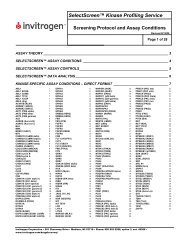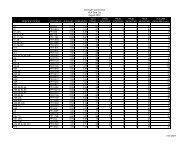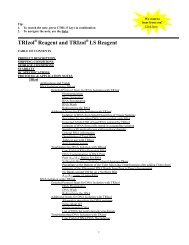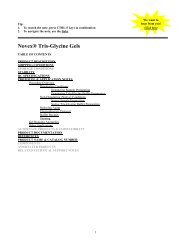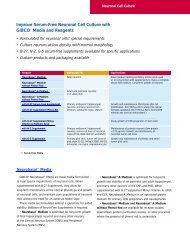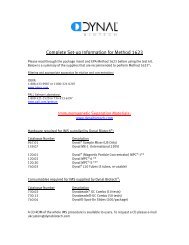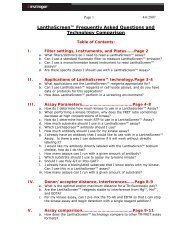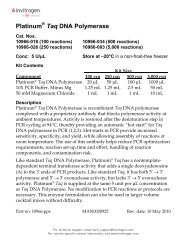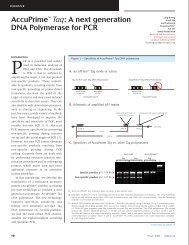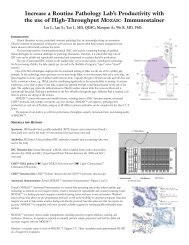Dynabeads® for specific capture (pdf) - Invitrogen
Dynabeads® for specific capture (pdf) - Invitrogen
Dynabeads® for specific capture (pdf) - Invitrogen
Create successful ePaper yourself
Turn your PDF publications into a flip-book with our unique Google optimized e-Paper software.
Tools <strong>for</strong> Nucleic Acid IVD<br />
Powering reliability <strong>for</strong> IVD<br />
assay development<br />
Dynabeads ® <strong>for</strong> <strong>specific</strong> <strong>capture</strong>
2<br />
Tools <strong>for</strong> Nucleic Acid IVD<br />
Specific <strong>capture</strong> solutions<br />
Dynabeads ® magnetic separation technology<br />
→<br />
→<br />
→<br />
Enhance the sensitivity of your assay<br />
Streamline your workflows<br />
Offer validated products <strong>for</strong> IVD<br />
Are you thinking about developing or improving a test <strong>for</strong> <strong>specific</strong><br />
nucleic acid targets? Would you like to increase the <strong>specific</strong>ity and<br />
sensitivity, expand the quantification, and reduce cost per reac-<br />
tion? Specific nucleic acid <strong>capture</strong> with <strong>Dynabeads®</strong> will provide<br />
definite advantages and introduce efficiencies to your assay.<br />
Reputation is earned<br />
<strong>Dynabeads®</strong> are well established as the gold-standard method<br />
<strong>for</strong> automated IVD sample preparation, and are integrated into<br />
more than 25,000 IVD instruments worldwide.<br />
Leading IVD companies choose <strong>Dynabeads®</strong> because of our<br />
ability to deliver IVD-grade products and ensure scale-up. As a<br />
company, <strong>Invitrogen</strong>’s Dynal® division can follow your projects<br />
from the early phases of R&D, through assay development and<br />
validation, into the IVD assay market.<br />
The IVD industry faces <strong>specific</strong> regulatory requirements.<br />
<strong>Invitrogen</strong>’s Dynal® division meets these today by complying with<br />
ISO 9001:2000 and ISO 13485:2003, and follows the requirements<br />
of cGMP when necessary. Furthermore, our quality system is<br />
based on customer requirements, enabling us to offer custom QA<br />
to support customers’ own GMP initiatives or local regulations.<br />
The tightly controlled production processes yield uni<strong>for</strong>m spheri-<br />
cal beads (Figure 1) with highly defined product characteristics.<br />
This ensures consistency in:<br />
→<br />
→<br />
→<br />
Size and surface area<br />
Surface chemistry<br />
Nucleic acid binding capacity<br />
Magnetic particles from alternative suppliers often have a<br />
random size range distribution and surface area that could com-<br />
promise the reproducibility of your assay results. 1<br />
Figure 1—<strong>Dynabeads®</strong> are monosized. The defined characteristics and unique<br />
level of con<strong>for</strong>mity (both within and between batches) ensure consistency<br />
and will contribute to highly reproducible assay results. 1
<strong>Dynabeads®</strong> make a difference<br />
Magnetic separation is very robust and flexible (Figure 2), and<br />
has revolutionized sample preparation in automated systems.<br />
With manual intervention greatly reduced, skilled technicians<br />
can drive more results per day when compared to other<br />
techniques (Figure 3).<br />
Choice of <strong>capture</strong> strategy<br />
To meet the <strong>specific</strong> requirements of your sample preparation<br />
and facilitate assay improvements, a range of <strong>Dynabeads®</strong> are<br />
available:<br />
→<br />
→<br />
→<br />
<strong>Dynabeads®</strong> Oligo(dT) 25 —<strong>for</strong> isolation of mRNA, solid phase<br />
reverse transcription, amplification, and detection<br />
<strong>Dynabeads®</strong> Streptavidin—<strong>for</strong> isolation of <strong>specific</strong> targets<br />
via a biotinylated <strong>capture</strong> probe—to allow further flexibility,<br />
four types of streptavidin-coupled beads are available<br />
<strong>Dynabeads®</strong> with custom-coupled probe—<strong>for</strong> isola-<br />
tion, solid-phase amplification, and detection of <strong>specific</strong><br />
sequences—optimized oligo probes are covalently coupled<br />
to the beads on an OEM basis<br />
Phenol extraction<br />
20 min<br />
Manual<br />
loading<br />
and lysis<br />
5–10 min<br />
Lysis and binding<br />
5–10 min<br />
Centrifugation<br />
6 min<br />
Centrifugation<br />
20 min<br />
Transfer<br />
and wash<br />
10 min<br />
Chloro<strong>for</strong>m process<br />
20 min<br />
Centrifugation<br />
and wash<br />
10–15 min<br />
A. Indirect <strong>capture</strong><br />
TTACGTAA<br />
AATGCATT<br />
Biotinylated <strong>capture</strong> probe is<br />
added to the sample prior to<br />
addition of beads<br />
TTACGTAA<br />
AATGCATT<br />
TTACGTAA<br />
AATGCATT<br />
AATGCATT<br />
B. Direct <strong>capture</strong><br />
TTACGTAA<br />
Specific <strong>capture</strong> probe<br />
is covalently coupled<br />
to the beads<br />
TTACGTAA<br />
AATGCATT<br />
TTACGTAA<br />
AATGCATT<br />
Figure 2—Indirect and direct <strong>capture</strong> methods. Nucleic acids are isolated from<br />
a lysed sample using either <strong>Dynabeads®</strong> Streptavidin and a biotinylated<br />
<strong>specific</strong> <strong>capture</strong> probe (A) or a <strong>specific</strong> <strong>capture</strong> probe covalently coupled to<br />
<strong>Dynabeads®</strong> (B).<br />
Centrifugation<br />
20 min<br />
Traditional manual phenol/choloro<strong>for</strong>m procedure (2–3 hr)<br />
Spin column procedure (45–60 min)<br />
Manual handling time up to 25 min<br />
Magnetic<br />
separation and<br />
elution<br />
15 min<br />
Dynabeads ® (20–25 min)<br />
Manual handling time
4<br />
Tools <strong>for</strong> Nucleic Acid IVD<br />
Table 1—<strong>Dynabeads®</strong> selection guide.<br />
mRNA<br />
<strong>capture</strong><br />
Solid-phase cDNA<br />
production<br />
Viral DNA/RNA<br />
<strong>capture</strong> from<br />
blood<br />
Solid-phase<br />
amplification<br />
Solid-phase<br />
detection<br />
Larger sample volume<br />
(0.5–1.5 ml)<br />
<strong>Dynabeads®</strong><br />
Oligo (dT) 25<br />
<br />
<br />
<strong>Dynabeads®</strong><br />
Streptavidin<br />
Customcoupled<br />
<strong>Dynabeads®</strong><br />
<br />
<br />
<br />
<br />
Well-defined<br />
primer set<br />
<br />
PCR clean-up <br />
Selection guide<br />
The range of <strong>Dynabeads®</strong> products will allow you to stream-<br />
line infectious disease testing or develop novel assays <strong>for</strong> gene<br />
expression and cancer diagnostics (Table 1). Your <strong>specific</strong> selec-<br />
tion strategy and assay design will determine which of the avail-<br />
able <strong>Dynabeads®</strong> are most suitable. The table below will help you<br />
select the optimal bead <strong>for</strong> your assay development or automa-<br />
tion program.<br />
Custom product development and optimization<br />
What are the <strong>specific</strong> requirements <strong>for</strong> your assay? Do you need<br />
a high level of <strong>specific</strong>ity and sensitivity? What about time and<br />
throughput? These <strong>specific</strong>ations define the need <strong>for</strong> develop-<br />
ment, automation, and streamlining of your workflows.<br />
Specific primer or probe sequences, types of samples, and<br />
target parameters often require optimization <strong>for</strong> a given assay or<br />
instrument. Such optimizations can include buffer development,<br />
larger sample volumes, or the parallel testing of different bead<br />
types (to assess binding, motility, etc.). We can advise and support<br />
the evaluation of <strong>Dynabeads®</strong> and ensure the required regulatory<br />
compliance <strong>for</strong> your assays or automated instrument. Contact us<br />
to find out how <strong>Dynabeads®</strong> can make a difference in your assays<br />
or automated instruments.
<strong>Dynabeads®</strong> Oligo(dT) 25 <strong>for</strong> direct mRNA<br />
<strong>capture</strong> and analysis:<br />
→<br />
→<br />
→<br />
Captures a representative mRNA population<br />
Offers the same mRNA yields as more labor-intensive methods<br />
Provides fast, robust, and automatable protocols<br />
The remarkable sensitivity allows even low copy number<br />
transcripts to be reliably <strong>capture</strong>d and detected, while providing<br />
easy magnetic handling <strong>for</strong> streamlined workflows (Figure 4). With<br />
no inhibition of enzymatic activity, mRNA isolation with Dyna-<br />
beads® Oligo(dT) 25 is directly compatible with reverse transcrip-<br />
tion and PCR.<br />
<strong>Dynabeads®</strong> Streptavidin <strong>for</strong> indirect biotinmediated<br />
<strong>capture</strong> and detection:<br />
→<br />
→<br />
→<br />
High capacity and a wide dynamic range<br />
Robust and flexible protocol development<br />
Ideal <strong>for</strong> target sequence optimization<br />
The indirect <strong>capture</strong> approach using a biotinylated probe is<br />
often preferred when the target concentration is low, when the<br />
<strong>specific</strong> affinity is weak, or when the binding kinetics are slow<br />
(Figure 5). <strong>Dynabeads®</strong> Streptavidin are seen as the gold standard<br />
and are widely used in the IVD industry.<br />
C t<br />
23.5<br />
23.0<br />
22.5<br />
22.0<br />
21.5<br />
21.0<br />
20.5<br />
β-actin<br />
medium size<br />
high copy<br />
XPO-1<br />
larger size<br />
low copy<br />
POLR2<br />
low size<br />
medium copy<br />
Figure 4—Representative mRNA population shown by RT-qPCR. Transcripts of different<br />
lengths and abundances were isolated using <strong>Dynabeads®</strong> Oligo(dT) 25<br />
(blue) and shown to be as effective as or better than (i.e., giving lower C t values)<br />
two total RNA isolation techniques (gray: <strong>Invitrogen</strong>’s TRIzol® Reagent;<br />
red: other commercially available product). The analyzed transcripts are<br />
β-actin (1,793 bases long, 1,500 copies per cell in active tissue), exportin 1<br />
(XPO-1, 4,148 bases, 129 copies) and RNA polymerase ll (POLR2, 392 bases,<br />
800 copies). As confirmed by the RT-qPCR analyses shown, magnetic <strong>capture</strong><br />
with <strong>Dynabeads®</strong> gives a highly representative mRNA population <strong>for</strong> a range<br />
of transcripts in terms of their size and abundance.<br />
Oligonucleotide bound (pmol/mg)<br />
600<br />
500<br />
400<br />
0.5 1.0 1.5 2.0 2.5 3.0 3.5 4.0<br />
Oligonucleotide added (nmol/mg beads)<br />
Figure 5—Highly consistent and predictable binding of biotinylated oligonucleotides.<br />
The amount of biotinylated oligo <strong>capture</strong> probe bound to <strong>Dynabeads®</strong><br />
Streptavidin is controlled by varying the amount of probe added. An excess<br />
of probe can be added to saturate the beads, but optimal assay per<strong>for</strong>mance<br />
is typically achieved at relatively low concentrations of <strong>capture</strong> probe. The<br />
amounts of <strong>Dynabeads®</strong> added were 5 mg/ml (red), 2.5 mg/ml (blue) and<br />
1.7 mg/ml (gray).<br />
www.invitrogen.com<br />
5
6<br />
Tools <strong>for</strong> Nucleic Acid IVD<br />
Custom-coupled <strong>Dynabeads®</strong> <strong>for</strong> direct coupling<br />
of <strong>specific</strong> primer/probe:<br />
→<br />
→<br />
→<br />
Process with reduced reagent usage, no biotinylation step<br />
Use with well-defined probe/primer targets, e.g. conserved<br />
regions of viral genomes<br />
Allows <strong>capture</strong> under high organic salt conditions, e.g. GTC<br />
Coupling of a <strong>specific</strong> <strong>capture</strong> probe will enhance solid phase<br />
amplification and detection while streamlining workflows, and<br />
offer economy of scale by removing the need <strong>for</strong> biotin reagents<br />
and a separate supply of oligos (Figure 6).<br />
1,000<br />
800<br />
600<br />
400<br />
200<br />
Eluted ssDNA (RU) 1,200<br />
0<br />
0 200 400 600 800 1,000 1,200 1,400<br />
Amount of beads (µg)<br />
Figure 6—Linear binding and reliable <strong>specific</strong>ity. A <strong>specific</strong> probe is coupled to<br />
<strong>Dynabeads®</strong> and used <strong>for</strong> <strong>capture</strong> from a 100 µl sample containing 4 pmol of<br />
a single-stranded (blue) and double-stranded (red) DNA fragment, 324 bp in<br />
length. The predictable per<strong>for</strong>mance of probe-coupled <strong>Dynabeads®</strong> is documented<br />
by the linear binding relationship between bead and target quantities.<br />
The reduced yield of dsDNA compared to ssDNA is explained by the competition<br />
between hybridization to immobilized <strong>capture</strong> probe and re-annealing of the<br />
dsDNA sequence. A non<strong>specific</strong> probe serves as negative control in both setups.<br />
The absence of significant binding confirms <strong>specific</strong>ity (purple and green).<br />
Advantages of magnetic separation<br />
<strong>Dynabeads®</strong> magnetic separation technology is rapid, robust, and<br />
reproducible. Larger sample volumes can be used to enhance<br />
detection sensitivity, while the target can be concentrated and<br />
aliquoted into one or more, smaller elution volumes <strong>for</strong> different<br />
downstream applications. The technology is:<br />
→<br />
→<br />
→<br />
Robust and easy to automate<br />
Versatile, adaptable to multiplex <strong>for</strong>mats<br />
Ideally suited <strong>for</strong> high-throughput systems<br />
Specificity, sensitivity, and reproducibility<br />
The unique consistency of <strong>Dynabeads®</strong> ensures a high level of<br />
reproducibility and drives reliability <strong>for</strong> your assays. Key advan-<br />
tages are:<br />
→<br />
→<br />
→<br />
Increased <strong>specific</strong>ity as targets are selectively purified prior<br />
to amplification<br />
Increased sensitivity by eliminating human DNA in patho-<br />
gen tests<br />
A variety of clinical samples can be used without inhibiting<br />
amplification<br />
<strong>Dynabeads®</strong> make good business sense<br />
In addition to thorough in-house product development, produc-<br />
tion processes, and exacting quality control, the per<strong>for</strong>mance<br />
and reliability of <strong>Dynabeads®</strong> has been extensively documented<br />
by many users in numerous published articles. 2–9
Accelerate time-to-market <strong>for</strong> your assays<br />
<strong>Dynabeads®</strong> are equally at home in a hands-on benchtop experi-<br />
ment as they are in high-throughput automated systems. We<br />
deliver the scale, product quality, and expertise to power your<br />
assay from R&D to your finished diagnostic test.<br />
Meeting the IVD challenge<br />
Diagnostic companies strive to develop assays with improved<br />
precision and sensitivity, while aiming <strong>for</strong> higher speed and<br />
throughput. Reliability in terms of efficiency and reproducibility is<br />
essential, as are the <strong>specific</strong> regulatory requirements.<br />
Specific <strong>capture</strong> using <strong>Dynabeads®</strong> helps you overcome<br />
these challenges. The kinetics, capacity, and reproducibility of<br />
the beads contribute to the streamlining and automation of your<br />
workflows. These are valuable advantages that will enhance the<br />
development of new IVD processes and instruments. <strong>Invitrogen</strong>’s<br />
Dynal division complies with ISO 9001:2000 and ISO 13485:2003<br />
(Figure 7), and supplies IVD-grade products on an OEM basis.<br />
Your innovation partner in IVD<br />
<strong>Dynabeads®</strong> provide innovation, along with proven per<strong>for</strong>mance<br />
and reproducibility <strong>for</strong> all your assays. As a preferred partner to<br />
leading IVD companies, we develop robust IVD-grade products<br />
from our existing biodiscovery portfolio, or by entering novel col-<br />
laborations.<br />
Contact us and let <strong>Dynabeads®</strong> magnetic separation tech-<br />
nology help solve your assay development needs. If you would<br />
like to discuss a potential collaboration or OEM agreement, please<br />
contact us by email, dynal@invitrogen.com.<br />
Figure 7—ISO certified and in line with US cGMP. <strong>Invitrogen</strong>’s Dynal division complies<br />
with ISO 9001:2000 (since 1996) and ISO 13485:2003 (since 2003), and<br />
follows the requirements of cGMP when necessary.<br />
www.invitrogen.com<br />
7
References and further reading<br />
1. In-house documentation (2002), Dynal Bead Based Separations, <strong>Invitrogen</strong><br />
Group.<br />
Diagnostic research and assay development using <strong>Dynabeads®</strong> <strong>for</strong> detection<br />
of viral pathogens:<br />
2. Stelzl, E. et al. (2002) Evaluation of an automated sample preparation protocol <strong>for</strong><br />
quantitative detection of hepatitis C virus RNA. Journal of Clinical Microbiology<br />
40(4):1447-1450.<br />
3. Meng, Q. et al. (2001) Automated multiplex assay system <strong>for</strong> simultaneous<br />
detection of hepatitis B virus DNA, hepatitis C virus RNA and human<br />
immunodeficiency virus type 1 RNA. Journal of Clinical Microbiology 39(8):2937-<br />
2945.<br />
4. Böni, J. et al. (2004) Detection of low copy numbers of HIV-1 proviral DNA in<br />
patient PBMCs by a high-input sequence <strong>capture</strong> PCR (Mega-PCR). Journal of<br />
Medical Virology 72(1):1-9.<br />
5. Stevens, S.J.C. et al. (1999) Monitoring of Epstein-Barr virus DNA load in peripheral<br />
blood by quantitative competitive PCR. Journal of Clinical Microbiology<br />
37(9):2852-2857.<br />
Recent research, new assays, and combined cell-enrichment strategies:<br />
6. Wang, B. et al. (2005) Rapid and sensitive detection of severe acute respiratory<br />
syndrome coronavirus by rolling circle amplification. Journal of Clinical<br />
Microbiology 43(5):2339–2344.<br />
7. Cornelissen, M. et al (2003) Gene expression profile of AIDS-related Kaposi’s<br />
sarcoma. BMC Cancer online 3:7.<br />
8. Zieglschmid, V. et al. (2005) Combination of immunomagnetic enrichment<br />
with multiplex RT-PCR analysis <strong>for</strong> the detection of disseminated tumour cells.<br />
Anticancer Research 25(3A):1803-1810.<br />
9. Reinholz, M.M. et al. (2005) Evaluation of a panel of tumour markers <strong>for</strong><br />
molecular detection of circulating cancer cells in women with suspected breast<br />
cancer. Clinical Cancer Research 11(10):3722-3732.<br />
©2007 <strong>Invitrogen</strong> Corporation. All rights reserved. These products may be covered by one or more Limited Use Label Licenses (see <strong>Invitrogen</strong> catalog or www.invitrogen.com). By use of these products you accept the<br />
terms and conditions of all applicable Limited Use Label Licenses. For research use only. Not intended <strong>for</strong> any animal or human therapeutic or diagnostic use, unless otherwise stated. B-068610-r1 0107 BBS.B.023.01<br />
www.invitrogen.com



